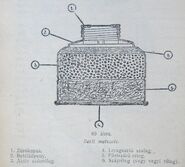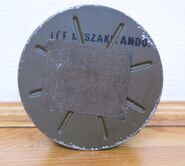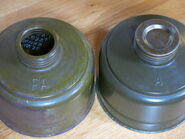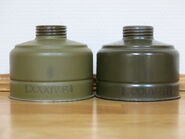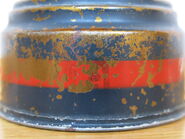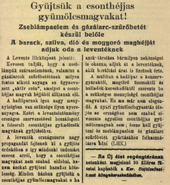There were many filters produced in Hungary during the Second World War and before it.
All of the filters has 40mm thread and a sticker covers the intake which had to be torn of before use.
- Szűrőbetét means "filter cartridge", this terminology is used for small, lightweight filters.
- Légtisztító means "air cleaner", this terminology is used for big and heavy filters.
27M szűrőbetét[]
The same canisters what the Austro-Hungarian army used in the First World War but refilled with a bit more modern substances. These were only used for training however there were dedicated training filters (27M Gy) which were not only used with the 27M but with the 28M as well. One training filter costed 4 Pengő.
28M légtisztító[]
The 28M gas mask is a licensed German GM24. So not that surprising that the 28M is very similar to the GM24 filter. It is a big flat box with grooves on the side to make it structurally stronger. It weights 800g. One filter costed 11 Pengő in 1934.
33M légtisztító[]
Also called as "tűzoltó légtisztító" was an industrial "F" filter, however it was marked with a "T" because in Hungarian "firefighter" is "tűzoltó" while in German it is "Feuerwehrmann". This filter was issued to the T. gázálarc. Very similar to the 28M filter, but the sieve wich separates the charcoal and the particle filtering layers is closer to the 3rd groove on the side. It weights 800g. One filter costed 10 Pengő in 1938, the training filter was 3 Pengő. Interesting to note that it was manufactured even before 1933 for industrial purposes, but its designation from that era is unknown.
33M szűrőbetét[]
In the early 30s Mercur managed to design its own lightweight filters, the first was the 33M for the 33M mask. It is a green painted cylindrical steel canister filter. It weights 430g. One filter costed 5,50 Pengő in 1935.
33M polgári szűrőbetét[]
The 33M P (Hungarian: Polgári - "civilian") is shorter and lighter than the normal 33M because it only contains particle filtering layer and charcoal, the diatomite soaked with chemicals is missing. It was intended for the passive population with the 33M P mask.
Industrial filters[]
Main article: Hungarian industrial filters
33M légtisztító and 33M szűrőbetét based filters painted with the appropriate colour.
34M and 41M szűrőbetét[]
The thechniques to make a lightweight filter were developed with the 33M filter so not surprising that the first filter designed for military purposes in Hungary used the same techniques. It is a green painted cylindrical steel canister filter. The shape is very similar to the later 70M filter but not identical. This filter was in service with the 34M and Gumi munkagázálarc and it was used with S.I.P. 3 as well. It was the base for the first Műszaki Művek industrial filters. It weights 460g. One filter costed 6 Pengő for the military (after 1936 this changed to 3,50) and 3,50 Pengő for civilians. During the war Mercur could produce at least 500000 fiters in a month. Protection time was 4 hours in 600 mg/m3 phosgene and 5 hours in 300 mg/m3 mustard gas.
The 34M filter was redeveloped in 1941 because during the Hungarian invasion of the Soviet Union the troops have found Zinc arsenate (Zn3(AsO4)2) powder in warehouses which is used to produce Arsine (AsH3). Arsine was used as a toxic agent and the filter of the 34M was nearly useless against it. So the army would have been suffered heavy loses in case of a gas attack. The redeveloped filter got additional chemicals to the chemical layer which protected against arsine and the canisters were marked with an “A” on the top of the filter. The modified filters reached the troops just after 3 weeks of the capture of the warehouses. This was possible because Mercur already produced industrial filters against arsine. This modification was only used on the 34M filter and this new filter is called 41M.
In 1943 the filter was updated again. This updated filter was much more efficient against phosporus smokes but it is unknown what was changed in the filter, but it got an FA marking on the top. Unofficial sources reffer to this filter as 43M. This variant was only produced till the end of the war.
Out of all filters listed in this article only the 41M was produced after the war. In the 1946-1949 period these were mostly refurbished filters, using the shells made during the war refilled with recycled substances from older filters, these filters can be easily identified because of the post-war Kossuth coat of arms and usually multiple layers of different coloured paint. After 1951 new filters were produced till the late 60s, lacking any markings.
36M szűrőbetét[]
The smallest and lightest filter among this four because this was only for civilians (Népgázálarc) and the chemical layer is missing making it much lighter compared to the 33M and 34M filters, 290g. It is a khaki painted cylindrical canister filter. One filter costed 2 Pengő 50 Fillér.
Unknown filters[]
There were experimental or short production run filters mostly for experimental or short production run masks.
Markings[]
There are 3-4 markings on most of these filters made between 1933-1945, especially on the 33M, 34M, 36M and 41M. These are stamped by the state and by the producer company. The easiest to indentify is the Hungarian coat of arms. The Roman number is the serial number while the letter following them is unknown but believed that those are sub series each split in two by the last roman number which is either I or II. Some 36M have an additional stamp on the top. Marking the month and the day of the production, while most other filters have arabic Arabic numbers on the top or bottom.
Substances[]
The substance of the 33M szűrőbetét and 34M szűrőbetét are well known. The first layer is Mercur's own patent, compressed goose down clusters, it is better as particle filter than compressed cotton or wool because it requires smaller place to fulfill the same filtering level and it lets air trough easier reducing the breathing resistnace. Compressed down clusters can even filter out both liquid and solid particles smaller than 0,02μm and in the filtering medium there are no small tubes unlike in compressed wool or cotton, hindering the performance. Goose down cluster is easily available in great quantities in Hungary so the filters were cheap to produce. This is the reason why the 34M filter is rather short and light compared to other filters from the era, even compared to filters with aluminium shell. The second layer is the activated charcoal, which was originally imported from Germany, distributed by Lurgi Gesellschaft für Wärmetechnik mb., was changed to the domestically produced one in 1937. The production was dome by Ipartermék Értékesítő Rt. based on the license of the Italian I.A.C. with changes and updates implemented. The third layer is diatomite soaked with hexamin, sodium carbonate and zinc oxide, unlike the activated charcoal which binds physically it binds chemically. The inside of the filters were coated with bakelite because the substances are very corrosive.
The 41M szűrőbetét is very similar to the 34M. The difference is that instead of zinc oxide, silver nitrate and copper carbonate are used. Later 41M filters use an other Mercur patent to reduce the size of the particle filtering layer even further but keeping its capacity and allowing more charcoal to be added extending the protection time of the filter against gases.
The P 33M and 36M szűrőbetét are similar to the 34M however lacking of the chemically binding layer but the charcoal is soaked with sodium carbonate.
The 33M légtisztító is basically an oversized 33M szűrőbetét but with additional iron oxide in the chemically binding layer. The other industrial filters contain different chemical compounds in the chemical layer.
The 28M légtisztító used compressed cotton as particulate filter instead of compressed goose down clusters, otherwise same as the 33M légtisztító.
References[]
- Légoltalmi ismeretek a lakóházi (önvédelmi) szervek részére II. kiadás (book-1952)
- Horler Ferenc: A polgári lakosság önvédelme légitámadások ellen (book-1938)
- Légoltalmi ABC (book-1939)
- Magyar Posta, 1936 (10. évfolyam, 1-10. szám)
- http://militiahungarorum.roncskutatas.com/1920_e_f_g_4.html
- Természettudományi Közlöny 1932 (64. évfolyam, 947-970. füzet)
- Marton András mk. hadnagy-Szél Szilveszter mk. hadnagy: AKTÍV SZENEK KAPACITÁSÁNAK VIZSGÁLATA
- Hungarian patent 109833, Mercur Műszaki és Vegyipari Rt., 1933.06.21.
- Hungarian patent 113411, Mercur Műszaki és Vegyipari Rt., 1935.04.09.














